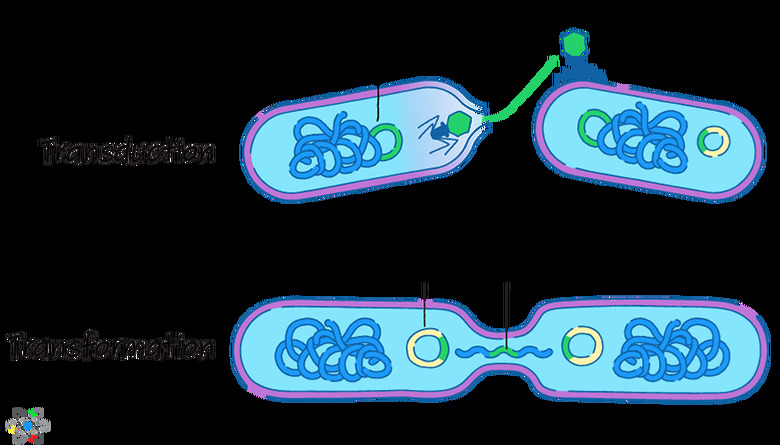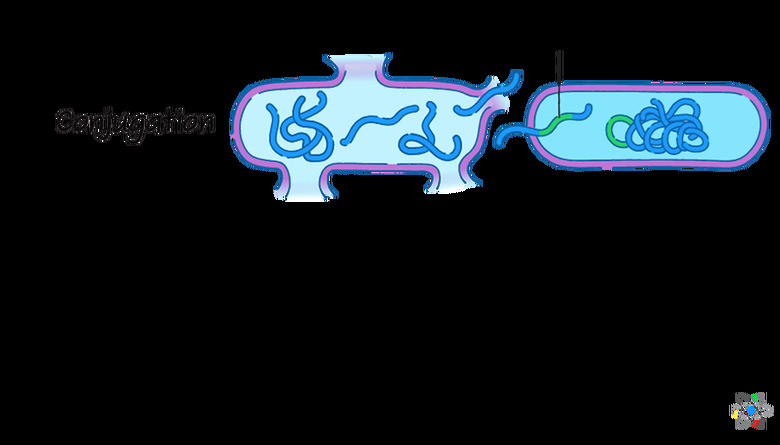Transformation, Transduction & Conjugation: Gene Transfer In Prokaryotes
Prokaryotes are one of two types of cells on Earth. The other is eukaryotes. Prokaryotes are the smaller of the two, lacking membrane-bound organelles and a defined nucleus. Prokaryotes, which are bacteria and archaea, are mostly single-celled organisms.
Eukaryotes reproduce sexually. Unlike eukaryotes, prokaryotes they reproduce asexually, copying themselves in a process called binary fission. A disadvantage to asexual reproduction is the lack of genetic variance from one generation to the next.
Sexual reproduction increases genetic variance, which provides protection to the species against environmental changes such as fluctuations in resources or predator populations, as well as other factors such as a random mutation that has the potential to wipe out most of a population. If there is diversity in the gene pool, the species is more sturdy and can withstand many unforeseen hardships.
Prokaryotes do not have the benefit of sexual reproduction, but they do still have the ability to increase genetic diversity through several types of gene transfer. One of the most important ways that prokaryotes (especially bacteria) engage in gene transfer is called transduction, and relies on the help of viruses.
TL;DR (Too Long; Didn't Read)
Prokaryotes are mostly unicellular organisms. They reproduce asexually through a process called binary fission. There are three kinds of gene transfer in prokaryotes that increase their genetic diversity. They are transformation, conjugation and transduction.
Transduction is important because of its implications for scientific research and bacterial antibiotic resistance. Transduction happens when a virus uses a bacterium cell to replicate itself by hijacking it.
Sometimes the virus accidentally packages some of the bacteria's DNA in a phage (viral cell component) instead of its own DNA. If that happens, the phage will go to another bacterium to infect it, but the phage will only inject the first bacterium's DNA into the recipient bacterium, where the DNA will be incorporated.
What Is Transduction in Prokaryotes?
What Is Transduction in Prokaryotes?
Gene transfer among archaea and especially bacteria is sometimes referred to as "horizontal" or "lateral" gene transfer. This is because genetic material is not passed down from parent bacterial cells to offspring cells, but between bacterial cells of the same generation. The genetic information moves horizontally on the family tree, instead of vertically.
Transduction was discovered in the 1950s by microbiologists Norman Zinder and Joshua Lederberg as they studied salmonella. It is one of the most important types of gene transfers, allowing bacterial DNA to move between cells.
Viruses that infect bacteria, called bacteriophages, make transduction possible. Since they move from one bacterial cell to another as infectious agents, they sometimes inadvertently grab up pieces of bacterial DNA from one host cell and deposit it in the next cell they bind to.
The Process of Bacterial Transduction
The Process of Bacterial Transduction
Viruses cannot reproduce on their own. Instead, they must use the more advanced reproductive cell biology of the bacteria to make copies of themselves. To do that, bacteriophages hijack host cells.
When a bacteriophage encounters a bacterial cell, it binds to the cell and injects phage DNA through the plasma membrane into the cell. There, it takes command of the cell's reproductive behavior. Instead of replicating its own genetic material, bacterium begins replicating new phage particles – components of virus cells.
The bacterial genes are degraded by the phages during this process. What is left of the bacterium is a replication machine for the virus.
The virus uses the bacterial cell to synthesize the protein scaffolding it needs for its components. Sometimes, it accidentally packages stray bacterial DNA into some of the phages along with the replicated viral DNA.
Once everything is ready, the virus lyses the bacterial cell. The bacterial cell bursts open, releasing the phages to bind to and infect other bacterial cells. Once bound, some of the phages will inject the bacterial genetic material they are carrying instead of viral DNA into the new bacterium.
Because the some of the phages are only carrying pieces of bacterial DNA, they cannot infect or lyse the new recipient cell. If the donor bacterial DNA fits into the new bacterial chromosome, the cell will express the genes as if they had always been there.
Why Is Transduction Important?
Why Is Transduction Important?
Transduction can quickly change the genetic makeup of bacterial populations even though they reproduce asexually. This type of gene transfer has the potential for profound effects on bacteria and the habitats they affect.
For example, many strains of bacteria are known to infect and cause disease in humans and other organisms. Antibiotics are a treatment that is usually effective to counter potentially dangerous or even fatal bacterial infections. Some bacterial strains are particularly difficult to eradicate, and require very specific antibiotics.
It is therefore of great concern when bacteria develop resistance to antibiotics – without the use of antibiotics, this could culminate in infections that spread in the body unchecked.
Transduction plays a role in antibiotic resistance. Some bacterial cells have a natural resistance to antibiotics on their cell membranes, making it hard for the antibiotic to bind there. This could be due to a random mutation and would not affect the overall effectiveness of the antibiotic.
However, if a bacteriophage infects an antibiotic-resistant bacterial cell and then transfers that mutated gene to other bacterial cells by transduction, more cells will be antibiotic-resistant, and as they reproduce by binary fission, the number of antibiotic-resistant bacterial cells could increase exponentially.
Using Transduction in Medicine
Using Transduction in Medicine
Transduction, however, has positive implications for humans and other higher life forms. Scientific research has been focusing on techniques and outcomes of controlled transduction with many potential applications.
Some scientists are interested in creating new medications or better medication delivery. Others are interested in creating genetically modified cells to further scientific understanding of genetics, or for new fields of medical treatments. They are even conducting experiments to observe transduction in non-bacterial cells.
Other Forms of DNA Transfer
Other Forms of DNA Transfer
Transduction is not the only type of gene transfer in prokaryotes. There are two more prominent kinds:
- Conjugation
- Transformation
Conjugation is similar to transduction in that DNA is moved directly from one bacterial cell to another. There are several important differences, however; most notably, conjugation does not rely on a virus to facilitate the gene transfer.
Bacteria have genes outside of the bacterial chromosome structure. These genes are called plasmids and are typically formed in rings made of double helices. During conjugation, a plasmid in the donor cell grows a projection that exits the plasma membrane and join the cell to a recipient cell. Once joined, it transfers a copy of its new DNA to the recipient before they detach.
Transformation is a method of gene transfer that was discovered in the mid-20th century; this discovery played a role in the discovery that DNA is the inherited trait information for all life on Earth. During transformation, bacteria pick up DNA from the environment outside of the cell. If it fits into their bacterial chromosome, it becomes part of their permanent genetic material.
References
- University of Idaho: Horizontal Gene Transfer in Prokaryotes
- Virology Blog: Norton Zinder, 1928-2012
- PLOS Genetics: A Review of Bacteria-Animal Lateral Gene Transfer May Inform Our Understanding of Diseases Like Cancer
- Arizona State University: Ask a Biologist: How Do Bacteria Become Resistant to Antibiotics?
Cite This Article
MLA
E., Rebecca. "Transformation, Transduction & Conjugation: Gene Transfer In Prokaryotes" sciencing.com, https://www.sciencing.com/transformation-transduction-conjugation-gene-transfer-in-prokaryotes-13717688/. 21 May 2019.
APA
E., Rebecca. (2019, May 21). Transformation, Transduction & Conjugation: Gene Transfer In Prokaryotes. sciencing.com. Retrieved from https://www.sciencing.com/transformation-transduction-conjugation-gene-transfer-in-prokaryotes-13717688/
Chicago
E., Rebecca. Transformation, Transduction & Conjugation: Gene Transfer In Prokaryotes last modified August 30, 2022. https://www.sciencing.com/transformation-transduction-conjugation-gene-transfer-in-prokaryotes-13717688/


